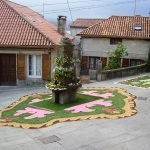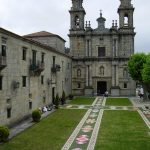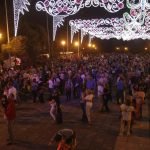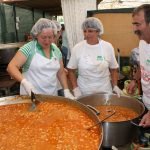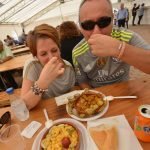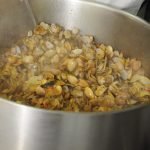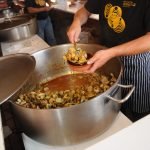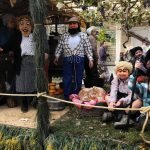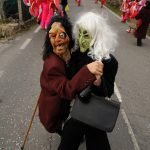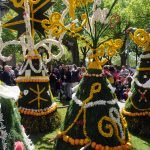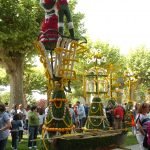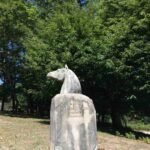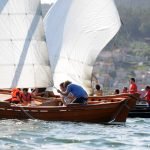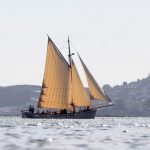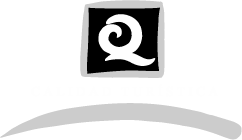Tradition and Modernity
In this section we will list the main festivals that are celebrated every year in Poio, grouped by theme: religious, gastronomic and popular festivals and new events such as the Festival of the Sea featuring the “Congregation of traditional boats” and the arrival of the “Sant Efflamm” expedition.
Corpus Christi (June)
A religious festival to celebrate the Eucharist that has a special relevance in the parishes of Combarro, Samieira, San Xoán and San Salvador because of the floral carpets that decorate the streets and squares. In Combarro, the floral carpets adorn the streets of the historical town and the Camino Real right the way up to the San Bernardo Church. In the parishes of San Xoán and San Salvador, these ephemeral rugs are also placed around the churches. In Samieira, one of the most notable acts is the Baile del ramo (dance of the bouquet), a tradition that dates back to the 19th century.
San Xoán (23 to 26 June)
The Festival or Night of San Xoán, the shortest of the year, is one of the festivals most deeply rooted in Galicia to welcome summer during the solstice. Traditions and rituals of purification such as lighting and jumping across the bonfires or washing with the herbal water of St John are carried out. This festivity is celebrated in a special way in Poio, since the Monastery was erected in honour of Saint John the Baptist and as such it is the patron saint festival of the municipality.
The celebrations begin on 23 June with the collection of herbs in the afternoon and at midnight there is the lighting of the bonfire, which is accompanied by a popular sardine with corn bread and wine from the country, in addition to a verbena music.
Mercé Festival (23 to 24 September)
The devotion to Our Lady of Mercy dates back to the settlement of the Mercedarian Order (1890) in the Monastery of Poio. Every 23 rd of September, around ten o’clock at night, a procession with the image of the Virgin leaves the old Sanatorium of La Merced (San Salvador), and on the last stretch of the road, it joins another processions from the chapel Our Lady of Fátima in Campelo, and from the church of San Bernardo in Combarro, they walk the final stage together to the Monastery of Poio. Once there, a night mass is celebrated after which roscón and queimada are distributed. On 24 September, the local feast day, liturgical and festive events are also held.
All the parishes of Poio celebrate festivals in honour of their patron saints and other saints, with dawns, parades, masses, processions and parades. Some of these are:
Festival of the Divine Saviour of Poio (6 to 7 August)
Festival of St Roque of Combarro (16 August)
Festival of St Gregory of Raxó (March)
Festival of St Antonio of Samieira (June)
Mussel Festival (15 August)
Since 1994, the cultural Ateneo Corredoira Association organises, as part of its Cultural Week, the tasting of mussels in Combarro´s Praza da Chousa, on the eve of San Roque. This product of the estuary can be enjoyed in its various elaborations.
One of the most emblematic events is the meeting in the chapel located in Xuviño to accompany the Virxe da Renda in its traditional baixada. It is a religious event that brings together dozens of followers who, together with traditional musical groups, accompany the procession to the temple of San Roque.
Tripe Festival (2nd Sunday in September)
The esplanade of A Seca (San Xoán) hosts the Festival of the Tripe, organised by the Boureante Neighborhood Association, since 2007. It consists of a tasting of meat stew with chickpeas, and other gastronomic products at popular prices, entertainment and traditional music.
Clam Festival (3rd weekend in September)
The oldest gastronomic event in Poio was born in 1988 in Campelo, promoted by the Campelo Neighborhood Association and the Fishermen’s Brotherhood, to promote the slug clam of the Pontevedra estuary. From 1992 onwards, the Poio Council took over the organisation of the festival, providing clam tastings (marinera style, with noodles or rice), a tribute event to retired shellfish gatherers, traditional music in the Praza da Granxa and other entertainment activities.
Entroido
A popular carnival festival with a long tradition in Galicia that begins three days before Ash Wednesday. It is a time of merriment and mockery in Poio, where the Galo Fodorico and the Galo Bruxo are protagonists for their uniqueness and their roots.
In the morning of the first Sunday, the Galo Bruxo parades through Samieira, and in the afternoon the parade of Entroido is celebrated in San Xoán de Poio with the Galo Fodorico.
Since 2012, the funeral of the Galo Fodorico was combined with the Festival of Choqueiros, the traditional figure of the Entroido that is dressed in extravagant garments. The contest in the Praza de Arís, which revives the tradition of dressing up with old and striking clothes, is accompanied by typical food of the time enlivened with music and dance. Similar celebrations are the funerals of the Berberecho in San Salvador and the Galo Bruxo de Samieira, in which the Filloa Festival is also celebrated.
Dances of costumes, activities and parades organized by neighborhood associations such as the Mexillon Burial in Combarro, make the Entroido of Poio one of the most complete, lively and extensive of the region.
Os Maios (1st week in May)
The square of the Monastery of San Xoán is filled with greenery, colour and music to celebrate the ancestral feast that welcomes spring. A visually stunning contest is organised at noon in which the best compositions are rewarded. This intergenerational party is deeply rooted in Poio. Wreaths which depict ships and satirical coplas that relate the events that occurred throughout the year, stand out. In the afternoon, the participants move to the Praza de Chousa de Combarro, where you can once again enjoy their showcase and performance.
Horse Festival (End of August)
This popular festival is celebrated on A Escusa hill, located on Castrove mountain (San Xoán), is organised by the Poio and Meis Communal Woodland. Popular known as the “Rapa das bestas”, this is the moment of the year when the aloitadores descend from the mountain upon wild horses to proceed with their marking and sale of foals in the closed enclosure called “curro”. The party consists of throwing the noose and catching the horses and then cutting their manes. For this, the young participants only use the strength of their arms and legs in a hand-to-hand fight with the animal.
Magosto (November)
An autumn feast celebrated in all parishes with a tasting of roasted chestnuts, young wine and traditional music. The San Martiño Chestnut Festival (in San Xoán de Poio) is held on 11 November, on the same day as its saint’s day.
Festa do Mar (End of August)
Since 2001 Combarro has hosted an event that combines gastronomy, music and maritime culture with a wide range of events for all types of audiences.
The festival programme includes a variety of activities (music, conferences, exhibitions, local gastronomy, etc.) among which the “Congregation of Traditional Boats” organized by the A Reiboa Yacht Club and the Festival “Armadiña Rock” organized by the Cultural, Sports Association and Environmental Armadiña.
Samaín en Campelo (End of October)
The town of Campelo (San Xoán), together with the Mulleres Arela Association, celebrates the pagan Samaim Festival on the last weekend before the 1st of November in the Praza da Granxa and its surrounding areas. The facades of their houses and streets are adorned and decorated with typical elements of this time of year, such as pumpkins.
Lively activities, workshops and competitions are organised in this event which is aimed at all ages. At dusk, around 7.30 p.m., the “cordoira” or parade of terror, begins, in which children over the age of five travel the town accompanied by adults. A jury awards the best decorated house on the occasion of this celebration.

